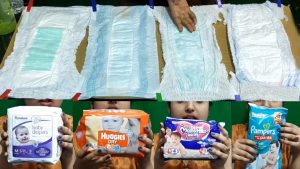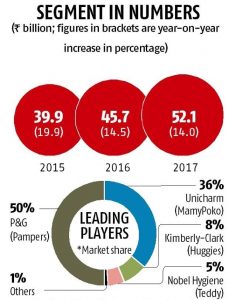Today, the disposable baby diaper has become a genuine concentrate of technology both in terms of the choice of its components and their use in the product to optimize their specific function and their combination with each other. The single-use diaper is continuously the subject of research and innovation aimed at improving: absorption, keep-dry, anti-leakage, breathability, skin protection, and baby’s comfort.

Related Projects: – Sanitary Napkins, Baby and Adult Diapers
The absorbent diaper is a blend of superabsorbent grains and wood cellulose fibers that give the cottony look moms talk about. Cellulose fibers absorb urine while ensuring its diffusion within the mattress. The superabsorbent retains at least 20 times its weight in urine, forming a gel. The urine is then trapped inside this gel, which prevents its contact with the baby’s skin—the baby’s diaper’s surface veil to protect the skin and keep it dry.
In contact with the baby’s skin, the surface veil consists of a nonwoven fabric based on polypropylene fibers. It transfers urine to the absorbent mattress while limiting the humidity in contact with the baby’s bottom: it is the keep-dry. It brings softness and comfort to the baby: outer casing, elastics, and leakage protection barriers.
The outer layer is the frame of the baby’s diaper. It consists of a film that liquids can absorb. Insulating the absorbent mattress, the disposable diaper’s outer cover keeps the bed and baby’s clothes from getting wet. Depending on the product, this film can have different aspects: textile, printed. It may or may not be breathable.
The anti-leak barriers are made of elastic bands and a hydrophobic nonwoven veil. With the elastic bands located around the thighs, they provide double protection against leaks.
Related books:- BOOKS & DATABASES
Why Baby Diaper Business is Worth Investing your Money?
The four-year forecast shows how the market is expected to change over the next few years. This report employs a comprehensive and iterative survey method that provides the most accurate estimates and forecasts possible with minimal errors.

The Indian diaper industry has grown at a CAGR of over 20% over the last five years, from December 2016 to December 2020. The diaper market is mainly made up of baby diapers from India, with over 95%, but adult diapers are still just beginning to enter the general market. In India, baby diapers are divided into five types: disposable diapers, modern cloth diapers, training pants, swim shorts, and biodegradable diapers that have a very low presence in the Indian market. Household hygiene products will soon change from luxury to “necessities,” and there is plenty of room for development. Diapers are not affordable for many in India, as they are considered a type of non-reusable luxury item in India. Also, unlike consumers in other diaper markets, Indian mothers believed that prolonged wearing of diapers could damage the baby’s skin. However, as socio-economic conditions and cultural patterns change, more and more Indian mothers accept baby diapers. Soft and breathable baby diapers fully meet the demands of the Indian market.
Related Video:- Baby Diaper & Sanitary Napkins-Market Survey cum Detailed Techno Economic Feasibility Project Report
Conclusion
Marketing strategies are primarily based on ensuring that our customers know our existence and the products we produce. Therefore, Niir Project and Consultancy Services (NPCS) intention are to make the right information available for businesses. This is done by implementing a market penetration strategy that ensures that we are well known and respected. Ensure that your products’ price is favourable compared to the cost of our products in South Africa and that potential customers appreciate the quality of products. However, the prices we charge also consider production and distribution costs to maintain viability and operability.
EVA_Art2021











